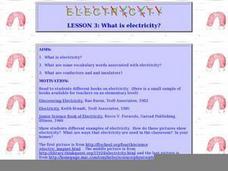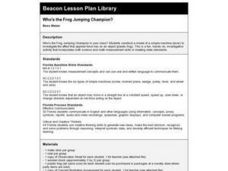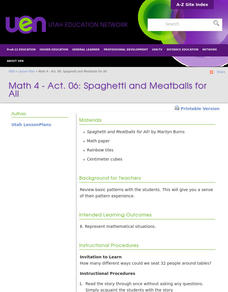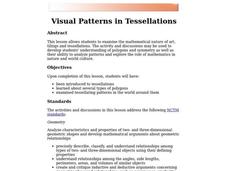Curated OER
What Is Electricity?
Students investigate vocabulary words associated with electricity. In this electrical lesson, students utilize the Internet to research what electricity is and how it works. Students create an actual circuit in class using a battery,...
Curated OER
From Where to Where?
Young scholars find locations based upon their latitude and longitude coordinates. In this latitude and longitude lesson, students locate points on a grid and learn how to use an astrolabe.
Curated OER
Who's the Frog Jumping Champion?
Students use a simple machine (a lever) to launch a plastic frog. students determine who is able to make their frog "jump" the farthest and graph the results.
Curated OER
Fraction Fun!
Fourth graders play a fraction game removing a fraction of a whole as the spinner dictates.
Curated OER
GUM: More, Less, or the Same?
Students confirm the law of conservation of matter by weighing chewing gum before and after it is chewed.
Curated OER
Maya Math: From Zero to Nineteen
Students explore counting methods of the ancient Maya, and practice identifying Maya number glyphs.
Curated OER
The Greatest Survival Story of All Time
Students use the Internet to read about an explorer's survival in the Antarctic. They try to find a better route for him to have taken.
Curated OER
Leaping Lemurs! How far can you jump?
Learners watch a segment of the PBS video which show the lemurs' ability to jump. In pairs, students collect measurement data involving each other's length of a standard step, a standing broad jump, and a long jump. They record their...
Curated OER
Plastic Wrap
Students compare the price and quality of different kinds of plastic kitchen wraps and then rank them from best to worst. They take into account how well it comes out of the roll, if it seals well, it is tangles, how much weight it...
Curated OER
Publishing With Photos!
Students create books with photographs as illustrations. In this book making lesson, students create books for different subjects to accompany what they are learning. They take photographs to match what they have written.
Curated OER
Learning to Make Bar Graphs
Students construct bar graphs using the results from various experiments. In this graphing lesson, students review data from a previous experiment and demonstrate how to construct a bar graph. Students use a checklist to ensure...
Curated OER
Pet Overpopulation: Spay or Neuter Song
Young scholars explore the importance of spaying animals through a song. In this spaying and neutering lesson, students calculate how animal numbers get larger quickly. Young scholars recognize the importance of taking good care of...
Curated OER
Mapping Your School Site
Students map a map of their school. In this school map lesson plan, students make a map of their school, record major features, and not wildlife on the school grounds.
Curated OER
Show Me!
Students analyze and interpret graphs. In this graphing instructional activity, students view a video and construct their own graphs (line, circle, bar) from given sets of data.
Curated OER
Weathering and Erosion Splashdown
Fourth graders investigate how plants and their roots help slow the erosion process.
Curated OER
Math 4 - Act. 06: Spaghetti and Meatballs for All
Fourth graders use manipulatives to practice math patterns.
Curated OER
Estimation Investigation
Young scholars view an interactive video to explore the concepts of estimation. They work cooperatively to measure, make comparisons, make predictions, and verify results.
Curated OER
Equivalent Fraction Munch with Pizza Pie
Pupils demonstrate fractions and mixed numbers using concrete pictorial models of pizza. They relate symbols to the models.
Curated OER
Visual Patterns in Tessellations
Students explore tessellations as well as various types of polygon. Students examine tessellating patterns in the world around them. Students examine tessellations by creating their own tessellations and completing the included worksheet.
Curated OER
Coordinate Graphs
Students use coordinate graphs in order to identify objects and their locations. They are shown how to plot the x and y coordinates and then are given values to be plotted during guided and independent practice. Students are assessed on...
Curated OER
Spaghetti and Meatballs for All
Fourth graders are read the story "Spaghetti and Meatballs for All". Individually, they are given a set of tiles and cubes to determine how 32 people can sit around tables. While being read the story again, they develop different...
Curated OER
Geometry of Exploration: Eyes Over Mars
Students research how engineers and scientists generate linear and angular measurements with geometry to survey the Earth and Mars. They assess how geometric shapes affect navigation. A surveyor comes to the classroom and explains how he...
Curated OER
How Close Can You Get? Estimating
Students work collaboratively to determine how many crackers are in a large container. They then view a video to see how often people use estimation in their jobs, and another video to watch students work on figuring out appropriate...
Alabama Learning Exchange
Number Clues
Students practice problem solving. In this number identification lesson plan, students practice identifying numbers based on clues or characteristics given. They also work in groups to identify the clues for given numbers.

























